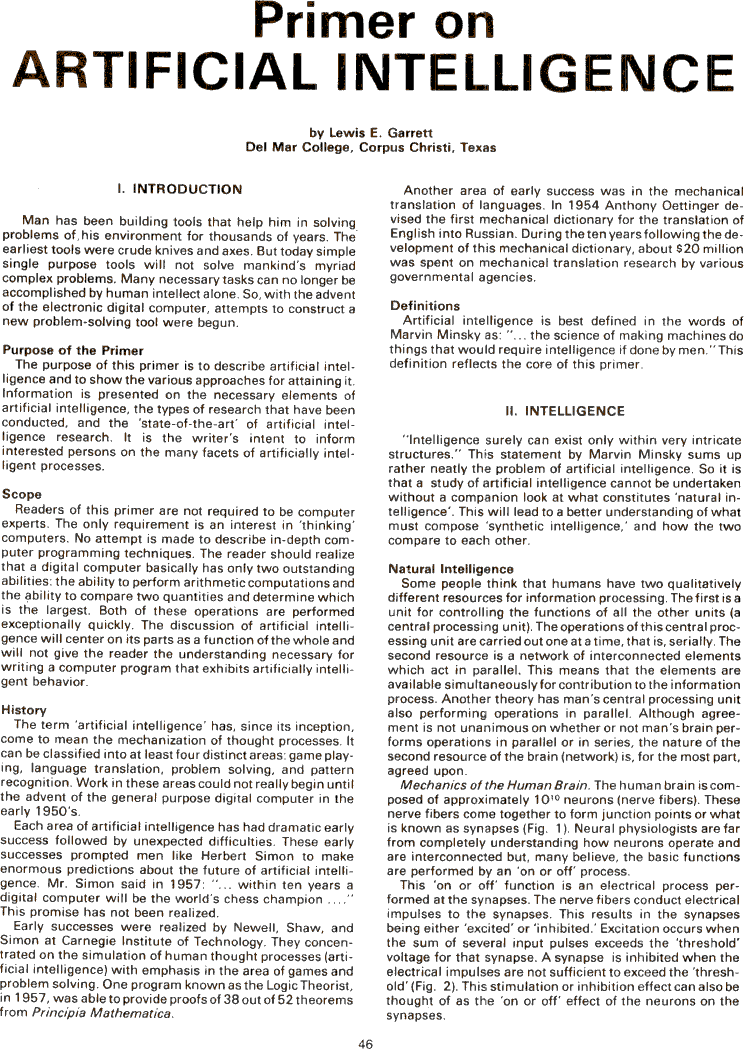by Lewis E. Garrett

Primer on ARTIFICIAL INTELLIGENCE by Lewis E. Garrett Del Mar College, Corpus Christi, Texas *** I. INTRODUCTION Man has been building tools that help him in solving problems of his environment for thousands of years. The earliest tools were crude knives and axes. But today simple single purpose tools will not solve mankind's myriad complex problems. Many necessary tasks can no longer be accomplished by human intellect alone. So, with the advent of the electronic digital computer, attempts to construct a new problem-solving tool were begun. *** Purpose of the Primer The purpose of this primer is to describe artificial intelligence and to show the various approaches for attaining it. Information is presented on the necessary elements of artificial intelligence, the types of research that have been conducted, and the 'state-of-the-art' of artificial intelligence research. It is the writer's intent to inform interested persons on the many facets of artificially intelligent processes. *** Scope Readers of this primer are not required to be computer experts. The only requirement is an interest in 'thinking' computers. No attempt is made to describe in-depth computer programming techniques. The reader should realize that a digital computer basically has only two outstanding abilities: the ability to perform arithmetic computations and the ability to compare two quantities and determine which is the largest. Both of these operations are performed exceptionally quickly. The discussion of artificial intelligence will center on its parts as a function of the whole and will not give the reader the understanding necessary for writing a computer program that exhibits artificially intelligent behavior. *** History The term 'artificial intelligence' has, since its inception, come to mean the mechanization of thought processes. It can be classified into at least four distinct areas: game playing, language translation, problem solving, and pattern recognition. Work in these areas could not really begin until the advent of the general purpose digital computer in the early 1950's. Each area of artificial intelligence has had dramatic early success followed by unexpected difficulties. These early successes prompted men like Herbert Simon to make enormous predictions about the future of artificial intelligence. Mr. Simon said in 1957: "...within ten years a digital computer will be the world's chess champion ...." This promise has not been realized. Early successes were realized by Newell, Shaw, and Simon at Carnegie Institute of Technology. They concentrated on the simulation of human thought processes (artificial intelligence) with emphasis in the area of games and problem solving. One program known as the Logic Theorist, in 1957, was able to provide proofs of 38 out of 52 theorems from Principia Mathematica. Another area of early success was in the mechanical translation of languages. In 1954 Anthony Oettinger devised the first mechanical dictionary for the translation of English into Russian. During the ten years following the development of this mechanical dictionary, about $20 million was spent on mechanical translation research by various governmental agencies. *** Definitions Artificial intelligence is best defined in the words of Marvin Minsky as: "... the science of making machines do things that would require intelligence if done by men." This definition reflects the core of this primer. *** II. INTELLIGENCE "Intelligence surely can exist only within very intricate structures." This statement by Marvin Minsky sums up rather neatly the problem of artificial intelligence. So it is that a study of artificial intelligence cannot be undertaken without a companion look at what constitutes 'natural intelligence'. This will lead to a better understanding of what must compose 'synthetic intelligence,' and how the two compare to each other. *** Natural Intelligence Some people think that humans have two qualitatively different resources for information processing. The first is a unit for controlling the functions of all the other units (a central processing unit). The operations of this central processing unit are carried out one at a time, that is, serially. The second resource is a network of interconnected elements which act in parallel. This means that the elements are available simultaneously for contribution to the information process. Another theory has man's central processing unit also performing operations in parallel. Although agreement is not unanimous on whether or not man's brain performs operations in parallel or in series, the nature of the second resource of the brain (network) is, for the most part, agreed upon. Mechanics of the Human Brain. The human brain is composed of approximately 10 10 neurons (nerve fibers). These nerve fibers come together to form junction points or what is known as synapses (Fig. 1). Neural physiologists are far from completely understanding how neurons operate and are interconnected but, many believe, the basic functions are performed by an 'on or off' process. This 'on or off' function is an electrical process performed at the synapses. The nerve fibers conduct electrical impulses to the synapses. This results in the synapses being either 'excited' or 'inhibited.' Excitation occurs when the sum of several input pulses exceeds the 'threshold' voltage for that synapse. A synapse is inhibited when the electrical impulses are not sufficient to exceed the 'threshold' (Fig. 2). This stimulation or inhibition effect can also be thought of as the 'on or off' effect of the neurons on the synapses. *** 46

